- Case-Based Roundtable
- General Dermatology
- Eczema
- Chronic Hand Eczema
- Alopecia
- Aesthetics
- Vitiligo
- COVID-19
- Actinic Keratosis
- Precision Medicine and Biologics
- Rare Disease
- Wound Care
- Rosacea
- Psoriasis
- Psoriatic Arthritis
- Atopic Dermatitis
- Melasma
- NP and PA
- Skin Cancer
- Hidradenitis Suppurativa
- Drug Watch
- Pigmentary Disorders
- Acne
- Pediatric Dermatology
- Practice Management
- Prurigo Nodularis
- Buy-and-Bill
News
Article
New TRoSA Scale Standardizes Telangiectasia Severity in Rosacea
Author(s):
Key Takeaways
- Rosacea prevalence varies, impacting quality of life due to visible symptoms like telangiectasia.
- The TRoSA scale, a 5-point photonumeric tool, was developed to standardize telangiectasia severity assessment.
Designed to fill a gap in rosacea evaluation, the TRoSA scale provides an objective method for tracking telangiectasia severity, which could also be integrated with AI for automated assessments.
Image Credit: © Rochu_2008 - stock.adobe.com

Rosacea prevalence is highly variable, reported between less than 1% and 22%, and it often impacts individuals’ quality of life significantly due to the visible nature of its symptoms.1 The Rosacea Consensus (ROSCO) recommends a phenotype-based diagnostic approach, focusing on primary manifestations such as erythema, telangiectasia, and inflammatory lesions. Among these, telangiectasia is a prominent feature, and the demand for effective treatments, including laser and light-based therapies, continues to grow.2 However, accurately assessing telangiectasia severity remains challenging, as there has been no standardized, validated photonumeric scale to date for evaluating this aspect of rosacea.3 A recent study addressed this gap by developing and validating a 5-point photonumeric scale, known as the Telangiectasia in Rosacea Severity Assessment (TRoSA) scale, to support dermatologists in clinical assessments and treatment planning.4
Methods
A database of rosacea patient images was created using high-resolution imaging (Vectra H2, Canfield Scientific Inc.). Researchers stated photos of the midface were taken in controlled settings, capturing frontal and angled views, focusing on the cheeks and nose. Exclusion criteria included makeup, tattoos, or other elements interfering with rosacea assessment. The final dataset included images from 132 patients with confirmed rosacea, aged 18 and older.
A panel of 3 dermatologists selected representative images to depict 5 severity grades of telangiectasia: 0-clear, 1-almost clear, 2-mild, 3-moderate, and 4-severe. To enhance consistency, the study stated that morphed images were created using a representative patient image for each severity category, allowing for standardized grading. The scale descriptions were also established for each grade, providing dermatologists with clear criteria for assessing severity.
To validate the scale, 50 images representing the 5 severity grades were uploaded to an encrypted digital platform, where 16 dermatology experts rated each image’s telangiectasia severity. The validation was repeated 14 days later to assess intrarater reliability.
The study stated that interrater reliability was determined through the intraclass correlation coefficient (ICC) for both validation rounds. Additionally, the mean weighted kappa statistic assessed intrarater reliability, with “almost perfect” interrater reliability and “substantial” intrarater reliability achieved, confirming the scale’s robustness.
Results
Researchers found the TRoSA scale proved effective, with high consistency across expert ratings. The interrater reliability was reported to be “almost perfect” with a high ICC score, while intrarater reliability demonstrated “substantial” agreement. A representative range of patient demographics and skin types (Fitzpatrick types I–IV) were included in the validation process, ensuring broad applicability. However, the study noted the scale's validation included more female than male patients, reflecting typical treatment-seeking behaviors. Fitzpatrick skin types V and VI were not represented, as rosacea diagnosis in these skin types is less frequent, potentially due to diagnostic challenges.
The study stated the TRoSA scale fills a critical gap in rosacea assessment by providing a validated, consistent tool for evaluating telangiectasia severity. The scale enhances clinical and research settings by enabling clinicians to make more precise severity assessments, aiding in treatment decisions and improving patient care. Researchers said current treatments, such as pulsed dye laser, KTP laser, and intense pulsed light (IPL), can be better tailored to patient needs when telangiectasia severity is accurately quantified.
Conclusion
While the TRoSA scale provides a valuable resource for telangiectasia assessment, researchers noted it does not encompass all rosacea symptoms, which means it should be used alongside a broader diagnostic approach that includes erythema, inflammatory lesions, and other primary features. Additionally, they stated the scale could potentially be integrated into AI-driven tools, leveraging machine learning to automate telangiectasia grading, thus streamlining the clinical evaluation process. This capability would facilitate objective, reproducible assessments in both routine care and large-scale clinical studies, advancing the overall management of rosacea.
Researchers stated theTRoSA scale represents a significant advancement in rosacea management, providing clinicians with a reliable tool for assessing telangiectasia severity. They noted this standardized approach to grading could also serve as a valuable metric in clinical trials, supporting the evaluation of treatment efficacy.
References
- van Zuuren EJ. Rosacea. N Engl J Med. 2017;377(18):1754-1764. doi:10.1056/NEJMcp1506630
- Schaller M, Almeida LMC, Bewley A, et al. Recommendations for rosacea diagnosis, classification and management: update from the global ROSaceaCOnsensus 2019 panel. Br J Dermatol. 2020;182(5):1269-1276. doi:10.1111/bjd.18420
- Carruthers A, Carruthers J. A validated facial grading scale: the future of facial ageing measurement tools?. J Cosmet Laser Ther. 2010;12(5):235-241. doi:10.3109/14764172.2010.514920
- Nguyen L, Seeber N, Baron J, et al. Validation of a photonumeric scale for evaluation of telangiectasia in rosacea. J Cosmet Dermatol. 2024. doi: 10.1111/jocd.16593






